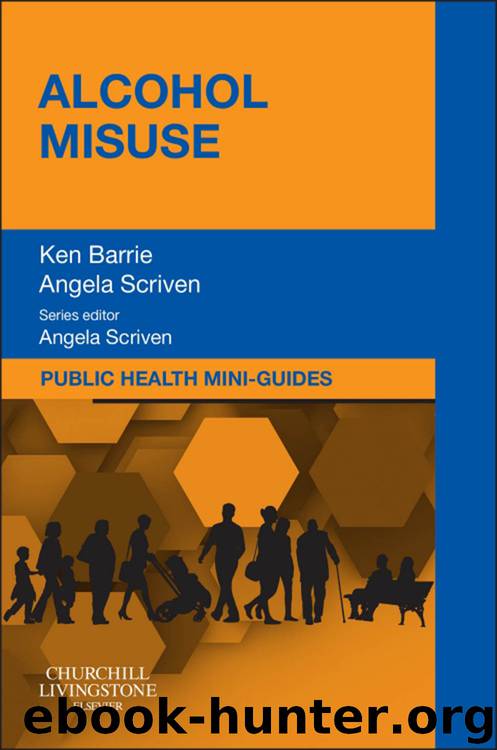Public Health Mini-Guides: Alcohol Misuse E-book by Scriven Angela & Barrie Ken

Author:Scriven, Angela & Barrie, Ken [Scriven, Angela]
Language: eng
Format: epub
Publisher: Elsevier Health Sciences
Published: 2014-06-13T16:00:00+00:00
Testing employees for alcohol
In recent years, technological innovation and increased commercial interest have made alcohol testing in the workplace simpler. Among organisations that test employees for alcohol misuse at work, the most common approach is to test when an employee is suspected of alcohol misuse as a result of work performance or inappropriate behaviour, namely ‘ for cause’ testing. Random testing in the workplace is rare in the UK, occurring in about 10% of those companies who test. The Trades Union Congress (TUC) considers testing only appropriate for staff in safety-critical settings, and it believes testing should be part of a comprehensive safety strategy, including support and treatment for those who test positive (TUC: http://www.tuc.org.uk/workplace/drugsandalcohol.cfm (accessed 12 August 2013)). A Chartered Institute of Personnel and Development (CIPD) (2007) survey showed that 22% of responding organisations tested employees for drugs or alcohol misuse, a modest increase on earlier 2001 findings. Of those questioned, 9% of organisations planned to introduce testing. Fifty-three percent of safety-critical organisations test, with a further 18% planning to do so. Of note, 65% of employers did not test and had no plans to do so. As these survey results are based on a 5% response rate, the views of non-responding employing organisations (95%) are unknown, and it may be concluded that, in the UK, testing in the workplace is a relatively uncommon practice. Drug testing can have an important role in safety-critical and other occupations where the public is entitled to expect the highest standards of safety and integrity; however, there is no justification for drug testing as a means of policing the private behaviour of employees, nor is it an appropriate tool for dealing with most performance issues (Independent Inquiry into Drug Testing at Work (UK) IIDTW, 2004 ; TUC: http://www.tuc.org.uk/workplace/drugsandalcohol.cfm (accessed 13 April 2013)). The reluctance of UK employers to test reflects prevailing cultural norms on alcohol and privacy as well as economic expediency. Generally, good management is considered the most effective method of improving workplace performance and tackling alcohol problems amongst staff and is preferred over testing (IIDTW, 2004 ).
Alcohol brief interventions and raising awareness in the workplace
Employment settings are common public health targets because the workforce represents a captive audience, there are similarities in employee characteristics, and the set of alcohol-related consequences (accidents, absenteeism) are specific to that organisation. Therefore, information and awareness campaigns, including brief interventions for hazardous and harmful drinkers, are commonly delivered by trained HR personnel and/or NHS health improvement professionals.
There is a significant body of evidence supporting the use of alcohol brief interventions (ABIs), which is discussed more fully in Chapter 6 . However, the application and evaluation of ABIs in the workplace in the UK is rare. In a trial of public sector employees receiving ABI, these employees reported reduced alcohol consumption and fewer days’ use of hospital services compared with those in a control group. This suggests that brief interventions in the workplace have the potential to reduce alcohol harm and also save resources. Additionally, more than
Download
This site does not store any files on its server. We only index and link to content provided by other sites. Please contact the content providers to delete copyright contents if any and email us, we'll remove relevant links or contents immediately.
The Hacking of the American Mind by Robert H. Lustig(4083)
Right Here, Right Now by Georgia Beers(3914)
Fingerprints of the Gods by Graham Hancock(3735)
Goodbye Paradise(3446)
Bad Pharma by Ben Goldacre(3095)
Happiness by Matthieu Ricard(2882)
More Language of Letting Go: 366 New Daily Meditations by Melody Beattie(2847)
The Social Psychology of Inequality by Unknown(2762)
Drugs Unlimited by Mike Power(2478)
The Plant Paradox by Dr. Steven R. Gundry M.D(2425)
Confessions of a Shopaholic by Sophie Kinsella(2156)
Borders by unknow(2116)
Dry by Augusten Burroughs(1990)
Make Love Not Porn by Cindy Gallop(1978)
Stop Being Mean to Yourself: A Story About Finding the True Meaning of Self-Love by Melody Beattie(1889)
Getting Off by Erica Garza(1850)
Yoga and the Twelve-Step Path by Kyczy Hawk(1743)
Belonging by Unknown(1728)
Unmasking Male Depression by Archibald D. Hart(1722)
